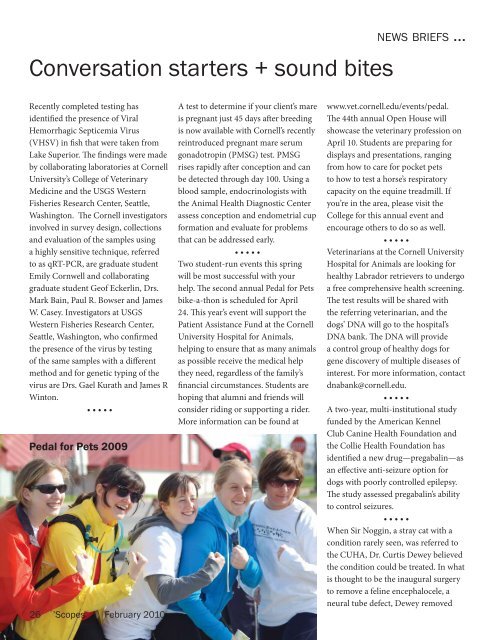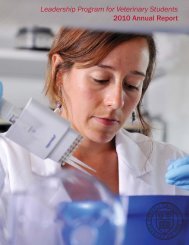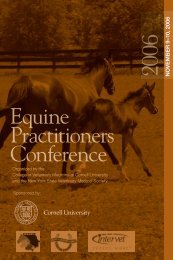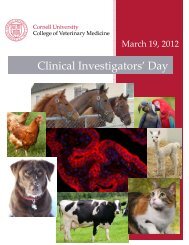From Classrooms to Clinics: - The College of Veterinary Medicine at ...
From Classrooms to Clinics: - The College of Veterinary Medicine at ...
From Classrooms to Clinics: - The College of Veterinary Medicine at ...
You also want an ePaper? Increase the reach of your titles
YUMPU automatically turns print PDFs into web optimized ePapers that Google loves.
Convers<strong>at</strong>ion starters + sound bites<br />
Recently completed testing has<br />
identifi ed the presence <strong>of</strong> Viral<br />
Hemorrhagic Septicemia Virus<br />
(VHSV) in fi sh th<strong>at</strong> were taken from<br />
Lake Superior. Th e fi ndings were made<br />
by collabor<strong>at</strong>ing labora<strong>to</strong>ries <strong>at</strong> Cornell<br />
University’s <strong>College</strong> <strong>of</strong> <strong>Veterinary</strong><br />
<strong>Medicine</strong> and the USGS Western<br />
Fisheries Research Center, Se<strong>at</strong>tle,<br />
Washing<strong>to</strong>n. Th e Cornell investiga<strong>to</strong>rs<br />
involved in survey design, collections<br />
and evalu<strong>at</strong>ion <strong>of</strong> the samples using<br />
a highly sensitive technique, referred<br />
<strong>to</strong> as qRT-PCR, are gradu<strong>at</strong>e student<br />
Emily Cornwell and collabor<strong>at</strong>ing<br />
gradu<strong>at</strong>e student Ge<strong>of</strong> Eckerlin, Drs.<br />
Mark Bain, Paul R. Bowser and James<br />
W. Casey. Investiga<strong>to</strong>rs <strong>at</strong> USGS<br />
Western Fisheries Research Center,<br />
Se<strong>at</strong>tle, Washing<strong>to</strong>n, who confi rmed<br />
the presence <strong>of</strong> the virus by testing<br />
<strong>of</strong> the same samples with a diff erent<br />
method and for genetic typing <strong>of</strong> the<br />
virus are Drs. Gael Kur<strong>at</strong>h and James R<br />
Win<strong>to</strong>n.<br />
• • • • •<br />
Pedal for Pets 2009<br />
26 ’Scopes | February 2010<br />
A test <strong>to</strong> determine if your client’s mare<br />
is pregnant just 45 days aft er breeding<br />
is now available with Cornell’s recently<br />
reintroduced pregnant mare serum<br />
gonadotropin (PMSG) test. PMSG<br />
rises rapidly aft er conception and can<br />
be detected through day 100. Using a<br />
blood sample, endocrinologists with<br />
the Animal Health Diagnostic Center<br />
assess conception and endometrial cup<br />
form<strong>at</strong>ion and evalu<strong>at</strong>e for problems<br />
th<strong>at</strong> can be addressed early.<br />
• • • • •<br />
Two student-run events this spring<br />
will be most successful with your<br />
help. Th e second annual Pedal for Pets<br />
bike-a-thon is scheduled for April<br />
24. Th is year’s event will support the<br />
P<strong>at</strong>ient Assistance Fund <strong>at</strong> the Cornell<br />
University Hospital for Animals,<br />
helping <strong>to</strong> ensure th<strong>at</strong> as many animals<br />
as possible receive the medical help<br />
they need, regardless <strong>of</strong> the family’s<br />
fi nancial circumstances. Students are<br />
hoping th<strong>at</strong> alumni and friends will<br />
consider riding or supporting a rider.<br />
More inform<strong>at</strong>ion can be found <strong>at</strong><br />
NEWS BRIEFS ...<br />
www.vet.cornell.edu/events/pedal.<br />
Th e 44th annual Open House will<br />
showcase the veterinary pr<strong>of</strong>ession on<br />
April 10. Students are preparing for<br />
displays and present<strong>at</strong>ions, ranging<br />
from how <strong>to</strong> care for pocket pets<br />
<strong>to</strong> how <strong>to</strong> test a horse’s respira<strong>to</strong>ry<br />
capacity on the equine treadmill. If<br />
you’re in the area, please visit the<br />
<strong>College</strong> for this annual event and<br />
encourage others <strong>to</strong> do so as well.<br />
• • • • •<br />
Veterinarians <strong>at</strong> the Cornell University<br />
Hospital for Animals are looking for<br />
healthy Labrador retrievers <strong>to</strong> undergo<br />
a free comprehensive health screening.<br />
Th e test results will be shared with<br />
the referring veterinarian, and the<br />
dogs’ DNA will go <strong>to</strong> the hospital’s<br />
DNA bank. Th e DNA will provide<br />
a control group <strong>of</strong> healthy dogs for<br />
gene discovery <strong>of</strong> multiple diseases <strong>of</strong><br />
interest. For more inform<strong>at</strong>ion, contact<br />
dnabank@cornell.edu.<br />
• • • • •<br />
A two-year, multi-institutional study<br />
funded by the American Kennel<br />
Club Canine Health Found<strong>at</strong>ion and<br />
the Collie Health Found<strong>at</strong>ion has<br />
identifi ed a new drug—pregabalin—as<br />
an eff ective anti-seizure option for<br />
dogs with poorly controlled epilepsy.<br />
Th e study assessed pregabalin’s ability<br />
<strong>to</strong> control seizures.<br />
• • • • •<br />
When Sir Noggin, a stray c<strong>at</strong> with a<br />
condition rarely seen, was referred <strong>to</strong><br />
the CUHA, Dr. Curtis Dewey believed<br />
the condition could be tre<strong>at</strong>ed. In wh<strong>at</strong><br />
is thought <strong>to</strong> be the inaugural surgery<br />
<strong>to</strong> remove a feline encephalocele, a<br />
neural tube defect, Dewey removed








